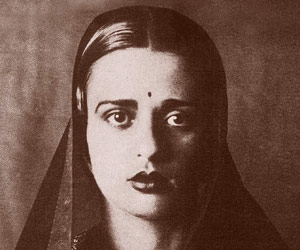Daughter
of a Sikh aristocrat, the beautiful Amrita SherGil (1913– 41), sailed with
her Hungarian mother toFrance to study art in Paris when she was only sixteen
year old. She learnt first at the Grande Chaumiere under Pierre Vaillant
and subsequently at the Ecole des Beaux-Arts, where she was taught by Lucien
Simon.
Sher-Gil
returned to India at the end of 1934, not yet twenty-two, but already a
technically accomplished painter, equipped with some of the most essential
ingredients that make an artist great – an unquenchable thirst to know,
a virile tenacity of purpose and a single-mindednesss about her role in
life. Sher-Gil sought to come to terms with her Indian heritge – being
only half Indian, she must have known that she would never have an insider’s
view of India or be able to claim a full share of its psyche.
While still a student in Paris, she wrote in a letter how she ‘began to be haunted by an intense longing to return to India, feeling in some strange way that there lay my destiny as a painter’. This was a remarkable statement for a twenty-year-old half-Indian woman, however westernized, to make in 1933. In those days, women of her background did not have vocations or careers; only lower-working-class women had jobs, and they were menial. Few Indian girls had an advanced education of any nature and those who did never took up a profession or employment, let alone declared their independence in such an unusual way as by becoming an artist. By her age, most women had been relegated to wedlock through the normal channel of an arranged marriage, and many had borne a couple of children. A casual remark by one of her Beaux-Arts tutors about her palette being more suitable for the colours and light of the East – as has been suggested by her nephew, the artist Vivan Sundaram – was all that it took to impel the impressionable girl, barely out of her teens, to long to hasten ‘home’.
Sher-Gil’s
statement was a powerful indication of her intent, revealing the passion
and the fire behind it. And, upon her return to India late the following
year, she lost no time in getting to grips with her ambition. In Paris
she may have been thirty years behind the European art movements and current
trends, as hinted at by Sundaram, but she was certainly as many years ahead
of her time in India in the mid-1930s – only in the 1960s did Indian artists
begin to display her kind of self-assurance and purpose.
She
went to live in Simla, the fashionable summer capital of the Raj in the
Himalayan foothills, where her liberated lifestyle caused a stir. She began
painting poor hill people who, to her romantic and naïve mind, embodies
the spirit of India. She gave them large doleful eyes and vacant stares,
exuding an expression of utter hopelessness. Her lanky and angular figures
shrouded in homespun materials look fragile and melancholic, reflecting,
perhaps, an inner melancholy of her own. The freshness and originality
of Ajanta and Ellora, the sensuous murals of the Mattancheri Palace in
Cochin and the strength of the Kushan sculpture which she saw at Mathura,
began to characterize her work. She became acquainted with Indian miniatures
and fell in love with the intense Basohli school. She even attempted to
include certain elements of Rajput painting in her later work, doing so
with feeling and flair and avoiding Abanindranath’s sentimentality.
Sher-Gil
has been accused of neither having any political awareness, nor identifying
with the national struggle for independence which was entering its final
phase during her last years. What, perhaps, she did not know was that she
would not live long enough to see how soon these strengths would rejuvenate
Indian art.




No comments:
Post a Comment